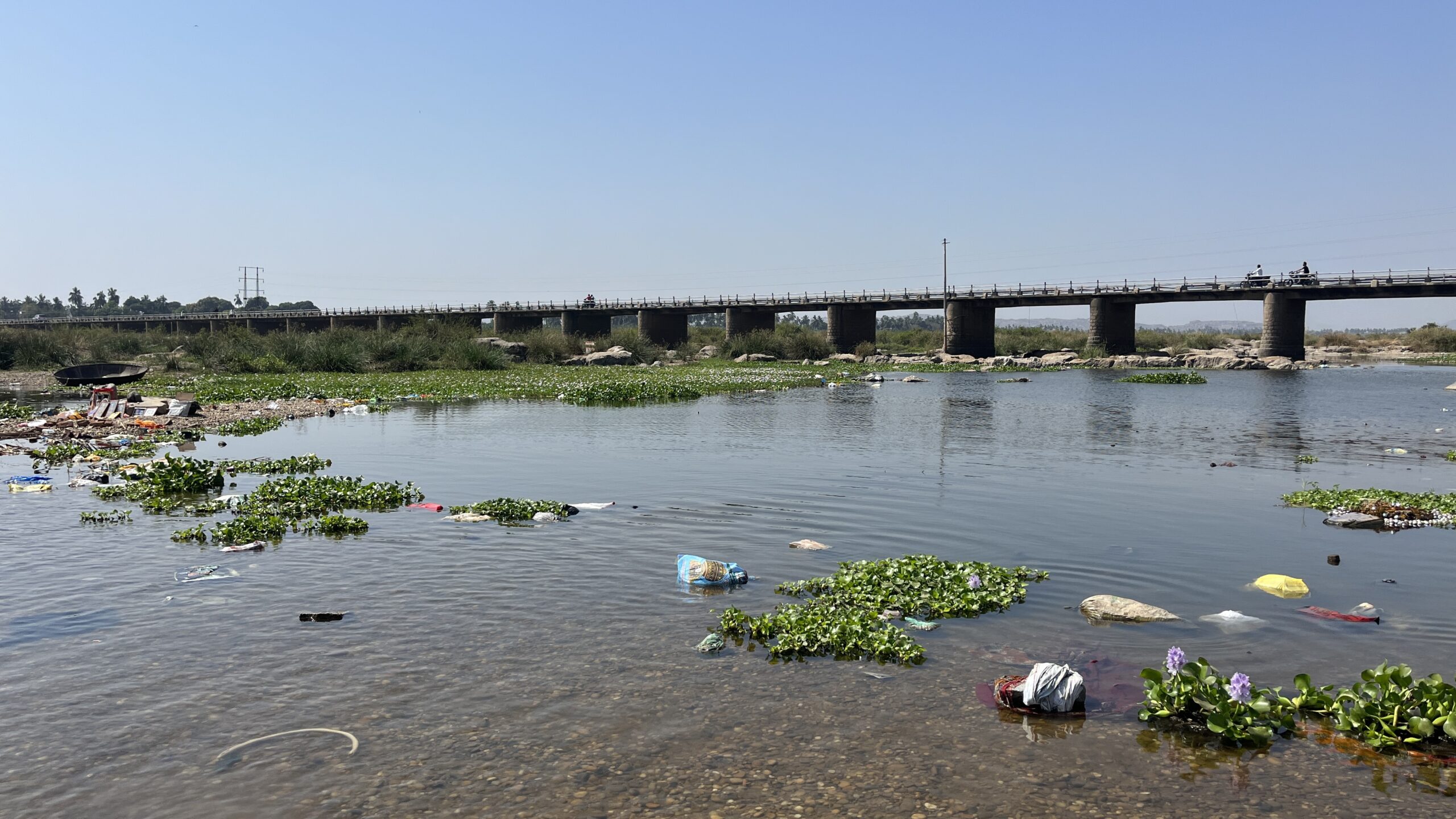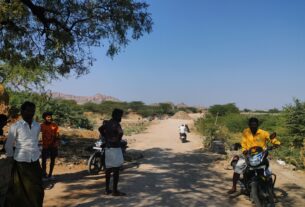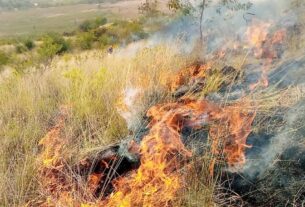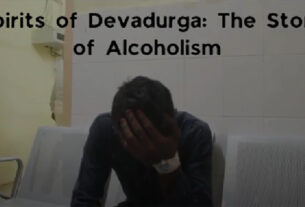Tungabhadra is classified as one of the most highly polluted rivers in India by the Central Pollution Control Board.
The sun was about to set, and Praveen was standing on the bank of Tungabhadra which flows to the northwest. Praveen went back to the time when he used to swim in the river, racing his friends, and catching fish to surprise his mom. Tungabhadra was a daily routine part for many, but unfortunately, it still is for some.
Praveen stopped swimming in the Tungabhadra after developing skin diseases and stopped drinking water directly from the river when its colour changed. According to the Central Pollution Control Board’s document published in 2022 on Polluted Rivers for Rejuvenation, the Tungabhadra River is classified as highly polluted.
People living on the banks of the Tungabhadra River are prone to viral diseases. Usha, casualty doctor, at Kampli Government Hospital said that gastroenteritis (stomach flu) is the most common type of disease seen among the people in Kampli. Nearly 250 patients consult in the Kampli Government Hospital every day, with at least 150 of them complaining of vomiting and diarrhoea.
According to the Action plan for rejuvenating the Tungabhadra River by the Karnataka State Pollution Board, the main contributors to the pollution are sewage from Harihar Municipality in Davangere Corporation and treated trade effluents from industries located on the banks of the river.
In addition to this, the Kampli Municipality’s sewage also joins the Tungabhadra River. Riyaz who lives near the Tungabhadra River said, “Waste water from all the houses in the village goes to the Tungabhadra and the villagers use the same water for their daily needs. Filtered water is not free or reliable.” Riyaz was admitted to the hospital with diarrhoea, and he said it is common in the village.
However, the Kampli municipality authorities said that there was no such sewage discharge into the river and the water in Tungabhadra “is clean like a mirror.”
What is Tungabhadra River?
According to UCN website, the Tungabhadra River, the largest tributary of the Krishna River, flows through Haveri, Davanagere, Koppal, Shivamogga, and Chikmagalur districts of Karnataka and Andhra Pradesh.
The Tungabhadra River serves as a crucial source of water for the drought-stricken districts in terms of irrigation and farming. Situated in the Bellary, Koppal, and Raichur districts, the Tungabhadra Dam is the major water source available to farmers of the area, who are the major rice producers in the state of Karnataka.
In addition to being a water resource, Tungabhadra is also a habitat for fishes like Tilapia Galilea, Catlacatla and Channa striata. Other than fishes, ecologically vital macroinvertebrates like insects, molluscs and crustaceans are seen in the river.
Ramakrishnan, a farmer in Gangavathi, said the Tungabhadra River was considered one of the finest rivers in India. The water in Tungabhadra is rich in nutrients, which is crucial to the farmers in Gangavathi. However, the presence of pollutants in the water is adversely affecting the growth and health of the crops now. As a result, the yield has decreased, and farmers are now required to use chemical fertilizers to make the crops healthy.
“When I began farming, chemical fertilizers were not necessary for making the crop healthy. Tungabhadra’s water had enough nutrients. The Tungabhadra River was crystal clear, and my family used its water for farming, drinking, cooking, and bathing. However, nowadays I am even afraid to drink filtered water,” Ramakrishnan added.
Dr A. V. Karegowda, a scientist at the Indian Institute of Soil and Water Conservation Research Centre, said that the Tungabhadra water is supplied to farmers in Gangavathi through a canal built in the Gangavathi city. Other than the pollutants in the river, the pollutants from the city also get mixed with the river water, he said. “The pollutants contain heavy metals. They decrease the oxygen content in the water and destroy the nutrients, not allowing crops like paddy to collect nutrients from the water. As a result, the farmers’ yield decreases,” he added.
According to the International Research Journal of Engineering and Technology, the total dissolved solids in the Tungabhadra River were found to be 964 milligrams per litre. This was due to sand mining and the dead organic substances produced by the decomposition of aquatic plants and animals. This exceeded the maximum limit of 500 milligrams per litre set by the World Health Organization (WHO) for total dissolved solids.
The pollution in the river has affected the fish species in the river as well. Nagaraj, an auto driver who used to go fishing in the Tungabhadra River, said the river was a place for fishing, swimming and praying. “I used to have a small boat that my friend and I would take out to the middle of the river when the river was big. We would then cook the fish on the riverbank. However, after factories were built near the river, there were several incidents of fish kill. Because of this, I stopped going fishing and I no longer eat fish from the river,” he said.

According to a study conducted by the Water Conflict Forum, the discharge of effluents into the river from industries caused fish kill in 75 villages. Other than pollutants from industries entering certain parts of the river, some individuals illegally use dynamite to catch fish in large quantities. This practice which happens two to three times a week in 10 different locations in the Tungabhadra sub-basin, kills all the fish in the area. Only a portion of the fish that are caught this way are collected, while the rest decompose and create a foul odour that pollutes the river and the surrounding ecosystem.
Aiyappa, a fisherman, who came back to the banks of the river to search for the fish caught in his nets, found more plastic instead. Aiyappa, who used to sell the fish he caught from the river right away on the bank, is now afraid to even eat the fish he catches.
The natives of the Kampli village also have a role in the plight of the Tungabhadra River. Tungabhadra is like a garbage bin now; people throw all kinds of stuff into the river. There are more plastic bottles than rocks in the river now. With the water drying up in the river during the summer, the plastic waste in the river is more evident, Aiyappa added.
According to reports, the samples collected from different areas of the river prove that the dissolved oxygen content in the river does not meet the minimum requirement to sustain life in the river.
Dr. Karegowda said that an action plan must be implemented to rejuvenate the Tungabhadra. “Sewage should be prevented from entering the river and people should be made aware of the implications of dumping garbage into the river. Strict actions being taken against the violators can stop the pollutants from entering the river,” he said. Additionally, illegal mining which results in sand being deposited in the river should also be stopped, he added.
In 2019, the Karnataka State Pollution Control Board (KSPCB) had proposed an action plan to rejuvenate the Tungabhadra River.
However, residents in Gangavati said that the action plan never came into force. Praveen, a resident of Gangavati said, “I am aware of an action plan that was proposed a few years ago, but unfortunately, it was never implemented. I hope that the new government will take action to implement the plan for the rejuvenation of the river, rather than taking water from it and purifying it to distribute among the villagers.”




